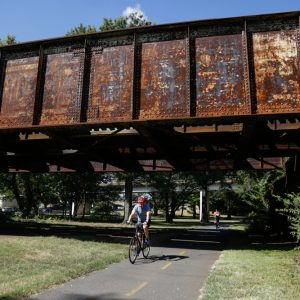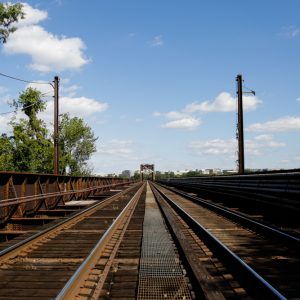WASHINGTON – Of the eight bridges connecting the nation’s capital to northern Virginia across the Potomac River, only one is a railroad bridge. And that one stands out for its, shall we say, reddish tint.
But plans are moving forward to renovate the rusting, 115-year-old Long Bridge, one of a cluster of five bridges that link the District of Columbia and Arlington along U.S. Route 1 and Interstate 395. Owned and operated by CSX Transportation, the two-track bridge currently carries freight, Amtrak and Virginia Railway Express commuter trains.
Repairs to the bridge are needed to withstand increased railroad capacity by 2040, according to a draft environmental impact statement released by the District Department of Transportation and the Federal Railroad Administration last month.
“Right now Long Bridge is one of our top priorities,” said Virginia Department of Rail and Transportation spokesman Chris Smith. “Any sort of passenger rail growth in the commonwealth can’t happen without more capacity.”
The limited number of tracks now causes bottlenecks and delays, a problem that needs addressing “not just for Virginia but for rail on the entire East Coast,” Smith said.

The preferred plan by DDOT and FRA would add another two-track bridge between the existing Long Bridge and the Metrorail span. The project, which would take five years and cost $1.9 billion, could also include a separate bike and pedestrian crossing.
A standalone bridge for bikers would be a “major improvement from the existing options,” said Washington Area Bicyclist Association spokesman Colin Browne.
Memorial Bridge, 14th Street Bridge on I-395, Key Bridge and Roosevelt Bridge all have varying amount of space for bicyclists, Browne said, but a dedicated bridge for bike riders is “certainly safer and less stressful.”
A bridge of some kind has stood at the site of the current railroad river crossing for over 200 years.
In 1808, President Thomas Jefferson signed a law authorizing the construction of a bridge connecting the City of Washington to Alexandria County. For a modest toll, foot, horse and stagecoach traffic could cross the timber bridge.
On August 25, 1814, one day following the Battle of Bladensburg during the War of 1812, British troops set fire to the north end of the bridge as they entered Washington. At the same time, American troops burned the south end of the bridge as they retreated to Virginia. After the war, the bridge was returned to service.
Fueled by rapid technological changes, the bridge added a railroad span in 1863 and has been reconstructed twice since. A steel, two-track iteration was built in 1904, and after a restoration in 1942, it has remained largely unchanged.
An alternative plan put forth by the District and federal government proposes building two new, two-track bridges to replace the Long Bridge entirely. That plan, however, would cost $2.8 billion and take over eight years to complete.
About 76 trains pass over the bridge daily, with volume on the bridge expected to rise more than 150 percent over the next two decades, according to the report.
Maryland Area Regional Commuter (MARC) train service, which currently serves Maryland communities and terminates at Union Station, plans to extend its service into Northern Virginia and would take advantage of the additional tracks.
DDOT and FRA are slated to release their final recommendation next year, and the agencies have not yet secured federal funding.

Construction on the Long Bridge would not begin until at least 2021, according to the report. The Virginia DPRT would handle the actual design and construction of the renovation.
The Council of the District of Columbia, which approves all DDOT spending, has not yet weighed in on the project.
However, the public is encouraged to submit comments on the agencies’ plans in advance of a hearing on the project.
That meeting will be held on Oct. 22, from 4:00 p.m. to 7:00 p.m. at 1100 4th St., S.W., in Room E200.

You must be logged in to post a comment.